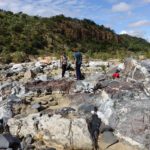Curtin University research has found that isolated Perth tiger snake populations, such as those surrounded by urban development or seawater, are more likely to resort to inbreeding than those in less ‘cut off’ communities.
A research team including lead author PhD candidate Mr Damian Lettoof and project supervisor Research Associate Dr Brenton von Takach, both from the School of Molecular and Life Sciences at Curtin, found Western tiger snake populations that were more geographically isolated were less genetically diverse than expected.
Mr Lettoof said the research focussed on six tiger snake populations across urban areas of the Swan Coastal Plain, and one offshore island.
“Tiger snake populations north of the Perth rivers at Herdsman Lake, Lake Joondalup and Yanchep National Park were found to lack genetic diversity while wetlands south of the Swan/Canning River system were home to the most genetically diverse populations of snakes, meaning they were less prone to inbreeding,” Mr Lettoof said.
“If tiger snake populations isolated by urbanisation are suffering from lower genetic diversity, they can lose their ability to adapt in order to survive ever-changing environments due to development, pollution and climate change.”
Mr Lettoof said populations north of the Perth rivers showed less genetic diversity likely because of a greater history of isolation from the rest of the species broader population.
“This is probably due to them being unable to cross unsuitable habitat such as large rivers, arid areas, and now the urban landscape,” Mr Lettoof said.
“Tiger snakes are near the top of their food chain and have very specific habitat requirements, meaning a wetland with a snake population lacking in genetic diversity was indicative of an ecosystem that was not healthy or well-functioning.
“This means many other small species – such as frogs, lizards and fish – living in these wetlands that are increasingly being ‘cut off’ by urban development may also be suffering and at risk of population decline and even extinction.
“Our research suggests larger wetlands being encroached upon by urbanisation such as those on the Swan coastal plain need to be managed as ‘islands’ of urban biodiversity in order to protect the animal communities inhabiting them.”
The research titled, ‘Bioindicator snake shows genomic signatures of natural and anthropogenic barriers to gene flow,’ can be found online here.



